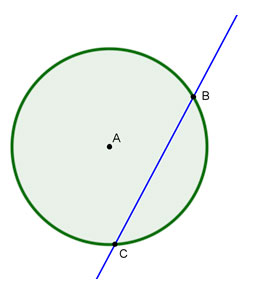

A secant of a circle is a line that intersects the circle in two points. In circle A,  is a secant because it intersects the circle at point B and again at point C.
is a secant because it intersects the circle at point B and again at point C.
Can a line ever intersect a circle at more than two points? What about fewer than two points? Use the interactive applet below to determine an answer to these questions.

![]() Click on the image below to access the applet.
Click on the image below to access the applet.
In the applet, click and drag an orange point to move the secant line around the circle.
In your notes, explain the difference between a secant and a chord.

As with chords, there is a special relationship when two secants intersect outside of a circle.
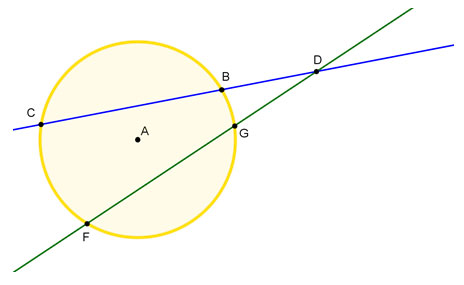
In circle A, there are two secants,  and
and  , that intersect each other at point D. There are four segments created between the point of intersection of the two secants, point D, and the points where each secant intersects circle A.
, that intersect each other at point D. There are four segments created between the point of intersection of the two secants, point D, and the points where each secant intersects circle A.
 : DB and DC
: DB and DC
 : DG and DF
: DG and DF

![]() Click on the image below to access the applet.
Click on the image below to access the applet.
In the applet below, click and drag an orange dot to investigate relationships among segments created by two intersecting secants to a circle.
Use what you observed in the applet to answer the questions below.
Interactive popup. Assistance may be required.
The two products are equal.
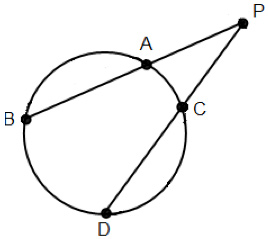
Interactive popup. Assistance may be required.
(PA)(PB) = (PC)(PD)
A chord is the portion of the secant line that lies within the circle. How does the formula from the Intersecting Secants Theorem, used when the point of intersection lies outside the circle, compare with the formula from the Intersecting Chords Theorem, used when the point of intersection lies inside the circle?
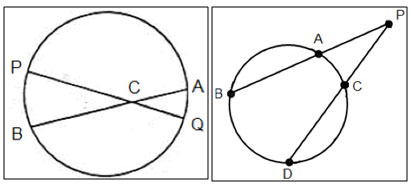
Interactive popup. Assistance may be required.
The product of the lengths of the two segments on a secant (or chord) formed by the intersection of two secants (or chords) to the two intersections of the secant (or chord) and the circle is equal to the product of the lengths of the corresponding segments of the other secant (or chord). In this aspect, the formulas are alike.
 and
and  are two secants of circle A that intersect at point D.
are two secants of circle A that intersect at point D.
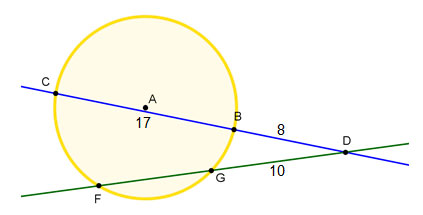
What is DF?
Interactive popup. Assistance may be required.
The product of the length of the segment between the intersection of two secants and the closer intersection of the circle multiplied by the length of the segment formed by the intersection of the secants and the farther intersection with the circle is equal to the product of the lengths of the corresponding segments for the other chord or secant.
Interactive popup. Assistance may be required.
DB(DC) = DG(DF)
 and
and  are two secants of circle A that intersect at point D, BC is a diameter of circle A, and BC = 23.
are two secants of circle A that intersect at point D, BC is a diameter of circle A, and BC = 23.
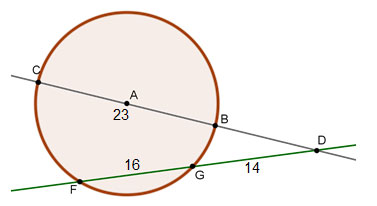
What is DB?
Interactive popup. Assistance may be required.
The products of the exterior segment (the segment between the intersection of the secants and the closer intersection of the circle) and the long segment (the segment between the intersection of the secants and the farther intersection of the circle) for each secant are equal.
Interactive popup. Assistance may be required.
DB(DC) = DG(DF)
You are given the lengths of DB, DG, and FG, so you need to determine the length of DF in order to use the Intersecting Secants Theorem.
DF = DG + GF
DC = 14 + 16
DC = 30
You need to determine the length of the exterior segment, so let DB = x.
DB(DC) = DG(DF)
x(x + 23) = 41(30)
x2 + 23x = 420
x2 + 23x – 420 = 0
(x – 12)(x + 35) = 0
x = 12, -35
DB = 12

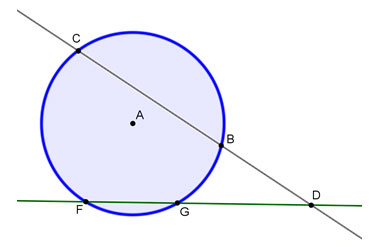
If DB is measured to be 26 feet, how long will the bridge be?
Interactive popup. Assistance may be required.
The products of the exterior segment (the segment between the intersection of the secants and the closer intersection of the circle) and the long segment (the segment between the intersection of the secants and the farther intersection of the circle) for each secant are equal.
Interactive popup. Assistance may be required.
DB(DC) = DG(DF)
You are given the lengths of GF, DG, and DB, so you need to determine the length of DF in order to use the Intersecting Secants Theorem.
DF = DG + GF
DF = 40 + 25
DF = 65
BC represents the portion of the long segment that is inside the circle, so let BC = x, and the long segment will be x + 26.
DB(DC) = DG(DF)
26(26 + x) = 40(65)
676 + 26x + 2600
26x = 1924
x = 74
The bridge will be 74 feet long.
